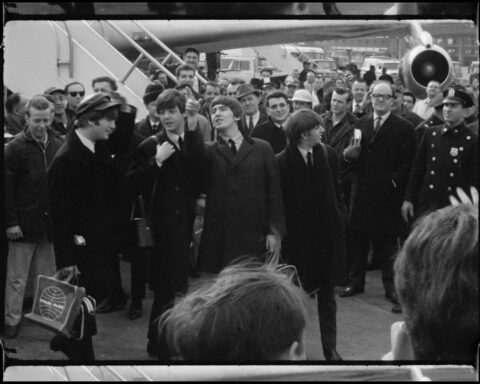Pamela, A Love Story
(USA, 112 min.)
Dir. Ryan White
Pamela Anderson is addicted to love. The actor, activist, and model reveals all in the Netflix portrait Pamela, a Love Story. Director Ryan White (Good Night Oppy) positions Anderson as a Cinderella figure in this look back at her life, career, and loves. Anderson’s most notable and notorious love, Mötley Crüe rocker Tommy Lee, meanwhile, might not strike many viewers as Prince Charming. However, the tattooed bad boy remains Anderson’s drug of choice as she reflects upon the highs and lows of their relationship. It’s the stuff of tabloids rather than fairy tales, which inevitably makes for a far juicier profile than the average rags to riches Cinderella story. This take on the Baywatch babe often surprises as it strips back the veneer of celebrity. The world has seen much of Pamela Anderson before, but she’s never laid herself so disarmingly bare.
Pamela, a Love Story checks in with Anderson as she lives away from the flashbulbs of paparazzi in her hometown of Ladysmith, British Columbia. Anderson speaks candidly and appears sans make-up to accentuate her vulnerability for most of the film. As White learns her story, the film invites viewers to look beyond the fame and glamour to see the woman beneath the cover girl image.
From Ladysmith to Hollywood
Anderson paints a story of humble beginnings as she remembers growing up in her small town on Vancouver Island. She also foreshadows the troubles that would cloud her adult life by talking openly about her parents’ tempestuous relationship. For a woman with enough marriages to rival Elizabeth Taylor, Anderson knows the fickle nature of making relationships work. She gives her parents credit for toughing it out, and later looks back on the role of motherhood while searching for answers regarding her troubles in finding love after Tommy Lee.
There’s also mention of a violent rape at age 12 by a man twice her age. Anderson’s story conveys a life marked by objectification and misogyny from an early age. While Anderson tells of her whirlwind rise in the USA after being spotted in a beer shirt at a local football game, she tells how Playboy came calling. Anderson doesn’t talk about her centrefold days with regrets, though. In fact, it’s quite the opposite as she shares how modelling empowered her by letting her own her sexuality teaching her to feel confident in her body.
Fans looking for novel details will inevitably enjoy some humanizing touches as the star shares the tricks that helped her sculpt Pamela Anderson as she is today. Her trademark blond locks, for one, come from hair dye that she still buys at the drug store. Her brand is Scandinavian Blond, and the film shows how it’s much easier to take the girl out of the small town than the small town out of the girl.
Here Comes Pam & Tommy
Besides the confessionals that White gets with Anderson, the film lets the star tell her story in her own words through diaries. Anderson resists revisiting the diaries herself with worries that re-reading them will prove painful. She gives White access to her thoughts, though, as a young woman soaring high in the entertainment industry. This voiceover testimony, read by an actor, puts Anderson’s story in the present tense. Although key actions in the film date to the mid-1990s, they echo events happening to young actresses today despite the reckoning of #MeToo.
Cinderella’s clock strikes midnight, though, when Anderson’s story reaches the inevitable crisis: the scandal that erupted when someone stole a sex tape of her and Lee. The film positions this violation as a cruel turning point in Anderson’s whirlwind marriage with Lee, but more notably in her career. Anderson likens the experience to the rape in her youth. White culls through the headlines and late night talk shows to illustrate how literally everyone talked about the sex tape. And how nobody expressed much sympathy for the stars who had the most personal item stolen from them, used as an extortive bargaining chip, and then circulated via bootleg DVDs and, eventually, the advent of the Internet for prying eyes to see.
Anderson insists twice in the film that she never made a cent off the video and refused offers for compensation, preserving her integrity while others profited from her exploitation. It’s admittedly distressing to see her still feel the need clear her name, so to speak, with the scandal as fresh as ever. Much of this story may be familiar terrain to viewers, but Pamela, a Love Story gets its best material when Anderson learns that Hulu’s miniseries Pam & Tommy aims to dramatize the scandal. The miniseries acts as another violation as Anderson again sees her life distorted for prying eyes.
“You can like the life you’re living / You can live the life you like”
While the scandal occupies considerable time, White doesn’t let it define Anderson’s story. Rather, Pamela, speaks to the entertainment industry’s reluctance to change. Anderson’s tale tackles pre-#MeToo sexism, but the success of the mini-series suggests that Hollywood hasn’t learned from the reckoning. It still peddles in exploitation.
White’s film therefore empowers Anderson anew. It affords her a level of self-reflection that her acting never did. The film culminates with Anderson’s triumphant Broadway debut in Chicago as she reintroduces herself. Her buoyant performance of “Nowadays” affords the film an unexpectedly powerful finale. While she doesn’t demonstrate the singing chops one expects for Broadway, she brings a stage presence, and a layer of vulnerability, that delights audiences. As the film climaxes with Anderson embracing a second wind, White gives her a fairy tale ending.
As a study in celebrity and biography, Pamela admittedly affords Anderson a measure of control that might invite discomfort. Her son, Brandon Thomas Lee, serves as producer and appears onscreen with his brother Dylan. Both sons are protective of their mother, understandably so. They watch family videos with Anderson and report on inaccuracies of the Hulu show, which inject the film with candid moments of verité.
Meanwhile, the section on Anderson’s activism focuses on the positive. However, there’s no mention of the impact, of say, her campaign against the seal hunt on Inuit communities. This portrait is very much on Anderson’s terms, but that’s also the point. The story is about redefining oneself and persevering in the public eye. The media never afforded her respect, but White does. In doing so, Anderson doesn’t go easy on herself. She’s her toughest critic, and the film’s the better for it. Pamela ultimately offers a cautionary tale about the danger of writing people off.













